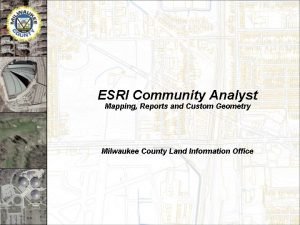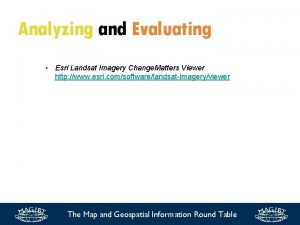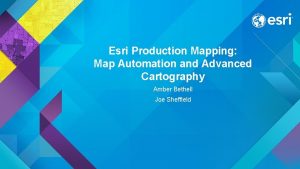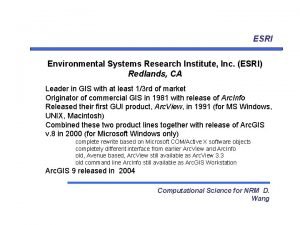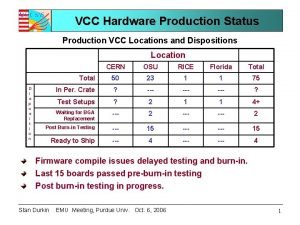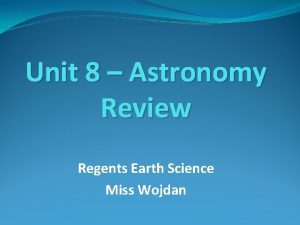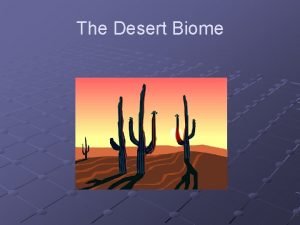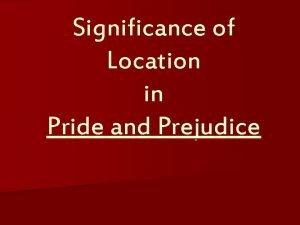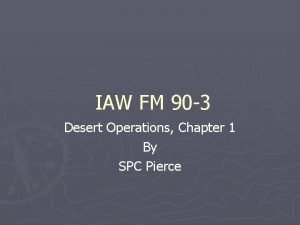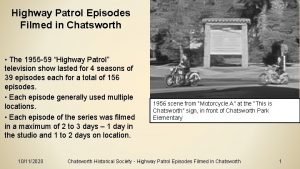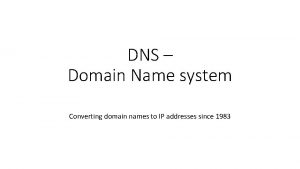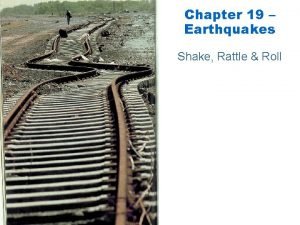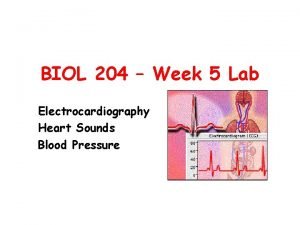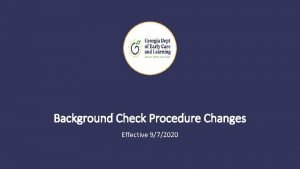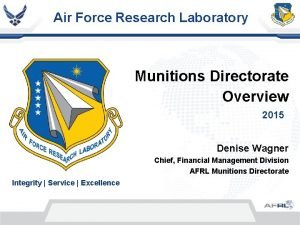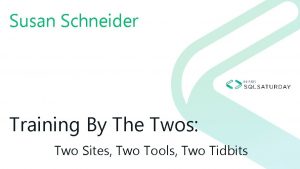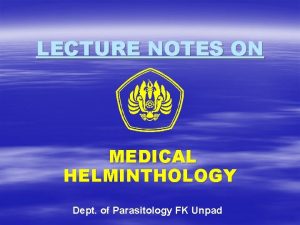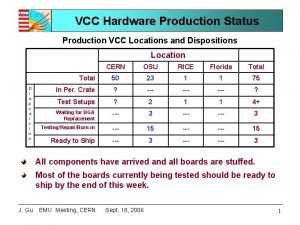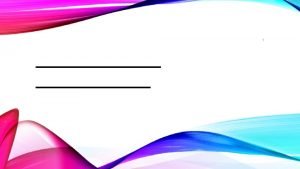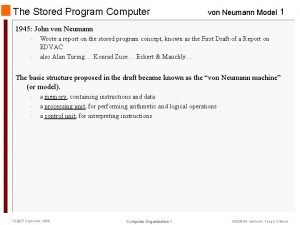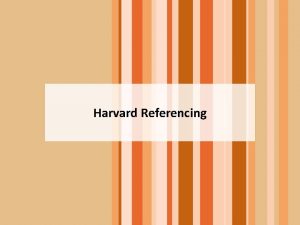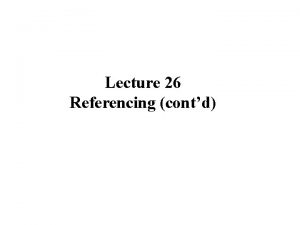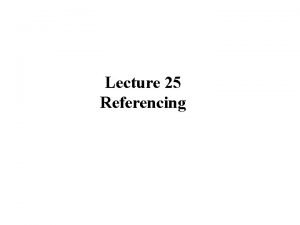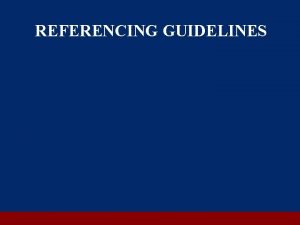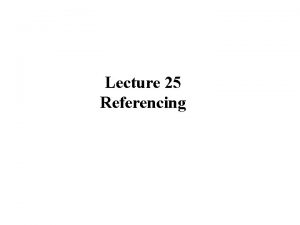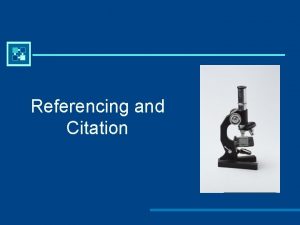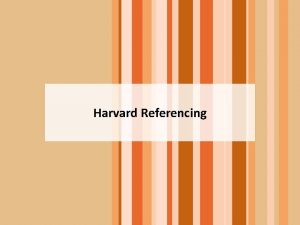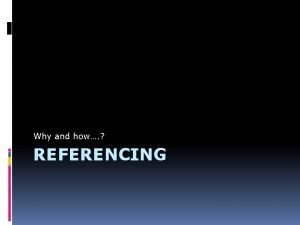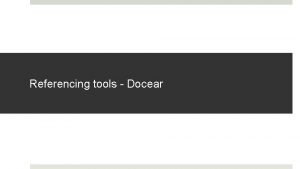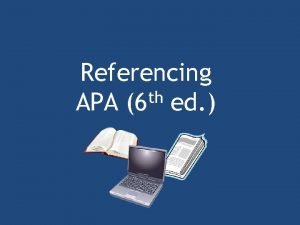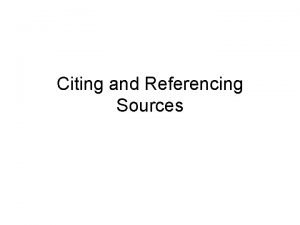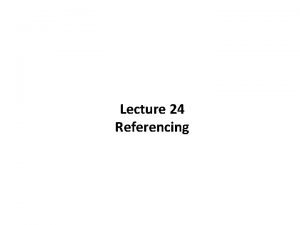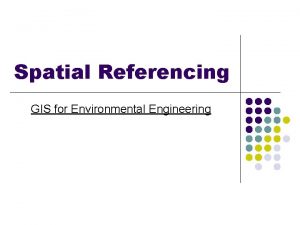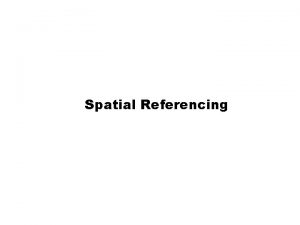Referencing Data to Real Locations Module 3 ESRI

































































- Slides: 65

Referencing Data to Real Locations Module 3 ESRI Virtual Campus Learning Arc. GIS Desktop Training Course ESRI Arc. GIS Statewide Curriculum

Referencing Data to Real Locations • A GIS represents reality, it is not reality. • A GIS map must accurately represent feature locations. • To determine location of features in real world or on map need a reference system – A set of lines of known location that can be used to determine the locations of features that fall between the lines Statewide Curriculum

Referencing Data to Real Locations • Coordinate Systems – Reference systems used to determine feature locations • In this module learn about – different coordinate systems – how they work – how to change the coordinate system of a map. • Understanding coordinate systems manage your data to increase accuracy Statewide Curriculum

Learning Objectives • • Name two types of coordinate systems. Identify components of each type of coordinate system. Assign coordinate system information to a dataset. Set display units for a data frame and measure distances on a map. Explain what a map projection is. List the major categories of map projections. List spatial properties that may be distorted when different map projections are applied. Change the map projection for a data frame and describe its effects. Statewide Curriculum

Understanding Coordinate Systems • Two types of coordinate systems – Geographic • Used to locate objects on the curved surface of the earth – Projected • Used to locate objects on a flat surface – a paper map or a digital GIS map displayed on a flat computer screen. • Each attempts to model earth and feature locations accurately – But no system is completely accurate Statewide Curriculum

Geographic Coordinate System • Reference system for identifying locations and measuring features on the curved surface of the earth • Consists of a network of intersecting lines called a graticule – Intersecting lines = longitude and latitude Statewide Curriculum

Geographic Coordinate System • Graticule – Longitude • Vertical lines – Latitude – Horizontal lines • Because earth is spherical, these lines form circles Statewide Curriculum

Geographic Coordinate System • Measurements expressed in – Degrees • 1/360 th of a circle. • Can be divided into 60 minutes – Minutes • Can be divided into 60 seconds – Seconds Statewide Curriculum

Geographic Coordinate System • Lines of longitude – Called meridians – Measures of longitude begin at the prime meridian • Defines zero value for longitude – Range from 0° to 180° going east – Range from 0° to 180° going west • Lines of latitude – Called parallels. – Measures of latitude begin at the equator – Range from 0° to 90° from the equator to the north pole – Range from 0° to 90° from the equator to the south pole Statewide Curriculum

Geographic Coordinate System • Prime meridian – Green line – Starting point for longitude – Has a value of 0 • Equator – – Red line Starting point for latitude Has a value of 0 Runs midway between the north and south poles • Dividing earth into northern and southern hemispheres. Statewide Curriculum

Geographic Coordinate System • Longitude and latitude actually angles measured from earth's center to point on earth's surface • For example, consider these coordinates: – Longitude: 60 degrees East (60° 00' 00") – Latitude: 55 degrees, 30 minutes North (55° 30' 00") • Longitude coordinate refers to angle formed by two lines – one at the prime meridian – the other extending east along the equator. • Latitude coordinate refers to angle formed by two lines – one on the equator – the other extending north along the 60° meridian. Statewide Curriculum

Geographic Coordinate System • Longitude and latitude are angles measured from the earth's center to a point on the earth's surface. Statewide Curriculum

Understanding Spheroids • Many models of the earth's shape – Each has its own geographic coordinate system • All based on – degrees of latitude and longitude • Exact latitude-longitude values assigned to individual locations will vary Statewide Curriculum

Understanding Spheroids • Two shapes commonly used to model earth – Sphere – Spheroid Statewide Curriculum

Sphere vs Spheroid • Assuming the earth is a sphere greatly simplifies mathematical calculations – Works well for small-scale maps • Maps that show large area of the earth • A sphere does not provide enough accuracy for large-scale maps – maps that show smaller area of earth in more detail • For those, it is preferable to use a spheroid • A spheroid is a more accurate model of the earth, but it's not perfect. Statewide Curriculum

Understanding Spheroids • Planet Earth – slightly pear-shaped and bumpy – has several dents and undulations – south pole is closer to the equator than north pole • Geoid – Model for complicated of earth – Too mathematically complicated to use for practical purposes, so spheroid is used as a compromise Statewide Curriculum

Understanding Spheroids • Different spheroids currently in use • Some spheroids were developed to – Model the entire earth – Model specific regions more accurately • World Geodetic System of 1972 (WGS 72) and 1984 (WGS 84) – Used to represent the whole world • Clarke 1866 and Geodetic Reference System of 1980 (GRS 80) – Most commonly used in North America Statewide Curriculum

Understanding Spheroids • Why do you need to know about spheroids? – Because ignoring deviations and using the same spheroid for all locations on the earth could lead to measurement errors of several meters or, in extreme cases, hundreds of meters. Statewide Curriculum

Understanding Datums • A spheroid doesn't describe the earth's shape exactly. • A geographic coordinate system needs a way to align the spheroid being used to the surface of the earth for the region being studied. • For this purpose, a geographic coordinate system uses a datum. – A datum specifies which spheroid you are using as your earth model and at which exact location (a single point) you are aligning that spheroid to the earth's surface. Statewide Curriculum

Understanding Datums • Red spheroid – Aligned to the earth to preserve accurate measurements for North America • Blue spheroid – Aligned to the earth to preserve accurate measurements for Europe Statewide Curriculum

Understanding Datums • Datum – Defines origin of geographic coordinate system • The point where the spheroid matches up perfectly with the surface of the earth and where the latitudelongitude coordinates on the spheroid are true and accurate. – All other points in the system are referenced to the origin. – In this way, a datum determines how your geographic coordinate system assigns latitudelongitude values to feature locations. • There are different datums to help align the spheroid to the surface of the earth in different regions Statewide Curriculum

Does Changing Datums Affect Your Data • If you change the datum of the geographic coordinate system, you should know that the coordinate values of your data will also change. • For example, consider a location in Redlands, California, that is based on the North American Datum of 1983 – The coordinate values of this location are: • – 117° 12' 57. 75961" (longitude) 34° 01' 43. 77884" (latitude) • Now consider the same point on the North American Datum of 1927 • – 117° 12' 54. 61539" (longitude) 34° 01' 43. 72995" (latitude) • The longitude value differs by about three seconds, while the latitude value differs by about 0. 05 seconds. Statewide Curriculum

Does Changing Datums Affect Your Data • In both NAD 1927 and the NAD 1983 datums – Spheroid matches the earth closely in North America – Is quite a bit off in other areas • Notice that the datums use different spheroids and different origins • NAD 1927 – origin aligns the Clark 1866 spheroid with a point in North America • NAD 1983 – Origin aligns the center of the spheroid with the center of the earth Statewide Curriculum

Does Changing Datums Affect Your Data • The most recently developed and widely used datum for locational measurement worldwide is – World Geodetic System of 1984 (WGS 1984) Statewide Curriculum

Projected Coordinate Systems • The surface of the earth is curved but maps are flat. • To convert feature locations from the spherical earth to a flat map – Latitude and longitude coordinates from a geographic coordinate system must be converted, or projected, to planar coordinates Statewide Curriculum

Projected Coordinate Systems • A map projection uses mathematical formulas to convert geographic coordinates on the spherical globe to planar coordinates on a flat map. Statewide Curriculum

Projected Coordinate Systems • Projected coordinate system – A reference system for identifying locations and measuring features on a flat (map) surface – Consists of lines that intersect at right angles, forming a grid – Based on Cartesian coordinates • Have an origin, an x and a y axis, and a unit for measuring distance Statewide Curriculum

Projected Coordinate Systems • Based on Cartesian coordinates which use a grid. • Feature locations are measured using x and y coordinate values from the point of origin. Statewide Curriculum

Projected Coordinate Systems • The origin of the projected coordinate system – (0, 0) – commonly coincides with the center of the map. • This means that x and y coordinate values will be positive only in one quadrant of the map (the upper right). – On published maps, however, it is desirable to have all the coordinate values be positive numbers. Statewide Curriculum

Projected Coordinate Systems • To offset this problem – Mapmakers add 2 numbers to each x and y value – Numbers are big enough to ensure that all coordinate values, at least in the area of interest, are positive values. – False easting • Number added to the x coordinate – False northing • Number added to the y coordinate Statewide Curriculum

Projected Coordinate Systems • A false easting value of 7, 000 was added to each x coordinate. • A false northing value of 2, 000 was added to each y coordinate. Statewide Curriculum

Working with Coordinate Systems in Arc. GIS • All geographic datasets have a geographic coordinate system (GCS). • Some datasets also have a projected coordinate system (PCS). • When you add a dataset to Arc. Map it detects the geographic coordinate system and the projected coordinate system if there is one Statewide Curriculum

Working with Coordinate Systems in Arc. GIS • If all the data you want to display on a map is stored in the same geographic coordinate system, you can just add it to the map—the layers will overlay properly. • If some of the datasets also have projected coordinate systems, even if they are different, you can also just add them to the map without data alignment worries— • Arc. Map will automatically make the layers overlay using a process called "on-the fly projection. " • The geographic coordinate system is the common language. • Arc. Map can convert the geographic coordinate system to any projected coordinate system and it can convert any projected coordinate system back to the geographic coordinate system. Statewide Curriculum

Working with Coordinate Systems in Arc. GIS • An issue arises when you want to display datasets that have different geographic coordinate systems on the same map. • The first layer you add to an empty data frame determines the coordinate system for the data frame. • If that layer has a projected coordinate system, the data frame will have that same projected coordinate system. • If you add a layer that has the same geographic coordinate system but a different projected coordinate system (or no projected coordinate system at all), Arc. Map will perform an on-the-fly projection and convert the data to the data frame's projected coordinate system. • The layers will overlay properly. Statewide Curriculum

Working with Coordinate Systems in Arc. GIS • If, however, you try to add a layer that has a different geographic coordinate system, Arc. Map will display a warning message telling you that it may not be able to properly align the data. • Arc. Map can still project the data on the fly, but it can no longer guarantee perfect alignment. – For perfect data alignment, you need to apply a transformation to make the geographic coordinate systems match Statewide Curriculum

Working with Coordinate Systems in Arc. GIS • How do you know what coordinate system your data is stored in? – You can view the coordinate system information for a dataset in Arc. Catalog™, in its metadata. – If a dataset has no coordinate system information in its metadata (it's missing), you may not be able to display the data in Arc. Map. – You may need to do some research to find out the coordinate system, then define the coordinate system using the Arc. GIS tools provided. Statewide Curriculum

Understanding Map Units and Display Units • Map units – Units in which coordinates for a dataset are stored – Determined by the coordinate system – If data is stored in a geographic coordinate system • Map units are usually decimal degrees – If data is stored in a projected coordinate system • Map units are usually meters or feet – Units can be changed only by changing the data's coordinate system. • Display unit – Independent of map units – Are a property of a data frame – The units in which Arc. Map displays coordinate values and reports measurements. – You can set the display units for any data frame and change them at any time. Statewide Curriculum

Decimal Degrees • Convert from DMS to DD • Latitude and longitude are • Latitude of London expressed angle measurements in DMS • Angles are measured in – 51° 29' 16" North. degrees. • To convert this location to DD, – Divide each value by the number • Degrees can be expressed of minutes (60) or seconds two ways: (3600) in a degree: • 29 minutes = 29/60 = 0. 4833 – degrees, minutes, degrees seconds (DMS) 16 seconds = 16/3600 = 0. 0044 degrees – decimal degrees (DD). – Add up the degrees to get the answer: • In a GIS, decimal degrees • 51° + 0. 4833 ° + 0. 0044 ° = 51. 4877 DD are more efficient because they make digital storage of coordinates easier and computations faster. Statewide Curriculum

Exercise • View and modify coordinate system information Statewide Curriculum

Working with Map Projections • Map projection – Used to convert data from a geographic coordinate system to a projected (planar) coordinate system • There are many different map projections – Each preserves the spatial properties of data (shape, area, distance, and direction) differently Statewide Curriculum

Work with Map Projections • Maps are always flat, so do you always need a map projection? – Maybe—it depends on what you want to do. • For example, suppose your project doesn't require a high level of locational accuracy—you won't be performing analysis based on location and distance or you just want to make a quick map. In these situations, there is probably no need to convert your data to a projected coordinate system. Statewide Curriculum

Work with Map Projections • Use a map projection to convert data to a projected coordinate system – If you need to perform analysis • measure distances, calculate areas and perimeters, determine the shortest route between two points – If you need to show a particular spatial property for features on a map as it really exists on the earth Statewide Curriculum

Types of Map Projections • The term "map projection" comes from the concept of projecting a light source through the earth's surface onto a two-dimensional surface (a map). Statewide Curriculum

Types of Map Projections • Map projections are created using mathematical formulas • There are three types of surfaces that a map can be projected onto: – Cylinder – Cone – Plane • Each of these surfaces can be laid flat without distortion. Statewide Curriculum

Types of Map Projections • Projections based on each surface can be used for mapping particular parts of the world • Cylinder – wrapped around the earth so that it touches the equator – accurate in the equatorial zone • Cone – placed over the earth so it touches midway between the equator and the pole – accurate in the mid-latitude zone • Plane – touches the earth at a pole – accurate in the polar region. • Knowing the surface used helps determine if the map projection is right for purpose Statewide Curriculum

Projections Based on a Cylinder • Produce maps with – straight, evenly-spaced meridians – straight parallels that intersect meridians at right angles • Created by – wrapping a cylinder around a globe – projecting a light source through the globe onto the cylinder – cutting along a line of longitude – Being laid flat Statewide Curriculum

Projections Based on a Cone • Produce maps with – straight converging longitude lines – concentric circular arcs for latitude lines • Created by – setting a cone over a globe – projecting light from the center of the globe onto the cone – cutting along a longitude line Statewide Curriculum

Projections Based on Plane • Produce maps on which • – longitude lines converge at the north pole and radiate outward – Latitude lines appear as a series of concentric circles Created by – passing a light source through the earth onto a flat surface (plane). – In this example, the plane touches the earth at the north pole. Statewide Curriculum

Understanding Distortion • Converting locations from a spherical surface to a flat surface causes distortion • Four spatial properties subject to distortion: – Shape – Area – Distance – Direction • Each map projection is good at preserving one or more (but not all) Statewide Curriculum

Understanding Distortion • Different map projections preserve different spatial properties and produce differentlooking maps. Statewide Curriculum

Understanding Distortion • Shape – Shapes, such as outlines of countries, look the same on the map as they do on the earth. – Called "conformal” – Compass directions are true for a limited distance around any given location Statewide Curriculum

Understanding Distortion • Area – Size of a feature on the map is the same relative to its size on the earth – If you draw a shape and move it around the map, no matter where you place it, its size will be the same Statewide Curriculum

Understanding Distortion • Distance – A line between one point on the map and another is the same distance as it is on the earth (taking scale into consideration). – Most maps have one or two lines of true scale. – An equidistant map preserves true scale for all straight lines passing through a single specified location • i. e. if the map is centered on Moscow, a linear measurement from Moscow to any other point on the map would be correct Statewide Curriculum

Understanding Distortion • Direction – Direction, or azimuth, is measured in degrees of angle from north – preserves direction for all straight lines passing through a single, specified location – Directions from one central location to all other points on the map will be shown correctly Statewide Curriculum

Understanding Distortion • The azimuth from A to B is 22 degrees. If the azimuth value from A to B is the same on a map as it is on the earth, then the map preserves direction from A to B. Statewide Curriculum

Understanding Distortion • Anyone who uses maps should know which projections are being used and which spatial properties are distorted and to what extent. • When choosing a map projection, think about which properties you want to preserve. – If your map is large-scale (shows a relatively small area of the earth), the effect of a map projection will be much less than if your map is small-scale (shows a large portion of the earth's surface). Statewide Curriculum

Choosing a Map Projection • Which map projection you choose for a particular map depends on – Map's purpose – Spatial properties you want to preserve Statewide Curriculum

Map Purpose • If map will be used for general reference or in an atlas – Want to balance shape and area distortion. – In this case, a compromise projection such as the Robinson projection may be the best choice. • If map has a specific purpose – May need to use a projection that preserves a specific spatial property Statewide Curriculum

Preserving Spatial Properties Statewide Curriculum

Choosing a Map Projection • Other factors to consider when choosing a map projection – the size of the area you're mapping, – the orientation (east-west or north-south) – the particular portion of the earth that is covered. • When working at a large scale – distortion doesn't play a big role – almost any projection centered on your area will be appropriate • In some situations, decision of which map projection to use has already been made – State Plane and UTM are standard for mapping U. S. states Statewide Curriculum

Exercise • Compare different map projections Statewide Curriculum

Review • All geographic datasets have a geographic coordinate system (GCS). • There are different spheroids for different parts of the world, and there are different datums to help align the spheroid with the surface of the earth in different regions. • As long as they have a common geographic coordinate system, Arc. Map can properly display multiple datasets in the same data frame using a process called "on-the-fly projection. " Statewide Curriculum

Review • In Arc. Map, the first layer you add to an empty data frame sets the coordinate system for the data frame. • You should use a map projection when you need to perform analysis, take accurate measurements, or when you need to show a particular spatial property as it really exists on the earth. • Anyone who uses maps should know which projections are being used and which properties are distorted and to what extent. Statewide Curriculum

Review Questions 1. What are the components of a geographic coordinate system? 2. Name one way you can get information about the coordinate system of a dataset in Arc. Catalog. 3. What are the two most important factors to consider when choosing a map projection? Statewide Curriculum

Review Answers 1. A geographic coordinate system is defined by a prime meridian (usually Greenwich), a datum (which includes a spheroid), and an angular unit of measure (degrees). 2. You can use the Metadata tab to view the coordinate system information for a dataset. You can also look at the dataset's Properties dialog box. 3. When choosing a map projection, you should consider the purpose of the map and which spatial properties you want to preserve. Statewide Curriculum
 Esri pearson vue
Esri pearson vue Esri maps for salesforce
Esri maps for salesforce Esri community analyst
Esri community analyst Esri landsat viewer
Esri landsat viewer Esri production mapping
Esri production mapping Mxdperfstat
Mxdperfstat Esri fed 2020
Esri fed 2020 Environmental systems research institute
Environmental systems research institute Esri products
Esri products Esri technical certification
Esri technical certification C device module module 1
C device module module 1 Pulse locations
Pulse locations Vcc locations
Vcc locations Ocean tides observed at coastal locations
Ocean tides observed at coastal locations Amt chapter locations
Amt chapter locations Duality memory locations
Duality memory locations Desert biome location
Desert biome location Locations in pride and prejudice
Locations in pride and prejudice Registry autostart locations
Registry autostart locations Korotkoff sound
Korotkoff sound Navfac southeast locations
Navfac southeast locations Goat lymph node locations
Goat lymph node locations Infiltration grading scale
Infiltration grading scale Dorsal surface of hand iv site
Dorsal surface of hand iv site Bdo cactus rind
Bdo cactus rind Hired killer highway patrol
Hired killer highway patrol Locations of savannas
Locations of savannas Root dns servers locations
Root dns servers locations Iv piggyback infusion
Iv piggyback infusion Transition ratio inflation ansys
Transition ratio inflation ansys The san andreas fault a result of horizontal shear is a
The san andreas fault a result of horizontal shear is a Body fat locations
Body fat locations 5 heart sound locations
5 heart sound locations Decal koala fingerprint locations
Decal koala fingerprint locations What two locations are marine ecosystems usually located
What two locations are marine ecosystems usually located Afrl locations
Afrl locations Add hobo dough
Add hobo dough Awg norfolk ne
Awg norfolk ne Pine environmental canada inc
Pine environmental canada inc South america angel falls
South america angel falls Rainforests of the world map
Rainforests of the world map Unplanned retail locations
Unplanned retail locations Sdsu card services
Sdsu card services Tetralogy of fallot heart sounds
Tetralogy of fallot heart sounds Rowan card
Rowan card Map of great gatsby locations
Map of great gatsby locations Schneider training locations
Schneider training locations Sble maryland
Sble maryland General parasitology lecture notes
General parasitology lecture notes Mobility express locations
Mobility express locations Lincoln fiduciary hub
Lincoln fiduciary hub How do you save panel locations and visibility preferences?
How do you save panel locations and visibility preferences? Active ride shop careers
Active ride shop careers Tropical rainforest biome locations
Tropical rainforest biome locations Sperious
Sperious Tecta america zero company
Tecta america zero company Pafcu
Pafcu Electrolus locations
Electrolus locations Asa guidelines for anesthesia in remote locations
Asa guidelines for anesthesia in remote locations Avg wetgeving
Avg wetgeving Modello von neumann
Modello von neumann Lymph nodes in legs location
Lymph nodes in legs location Tropical deciduous forest rainfall
Tropical deciduous forest rainfall Hyponatrema
Hyponatrema Fiorano esb
Fiorano esb Man of war habitat
Man of war habitat


